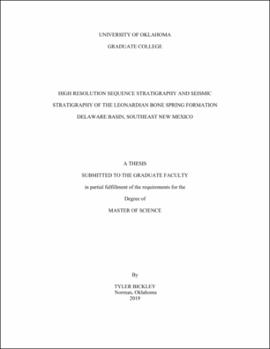| dc.description.abstract | A high-resolution sequence stratigraphic investigation integrating 3D seismic with petrophysics of the Leonardian Bone Spring Formation, Northern Delaware Basin, New Mexico reveals the sedimentologic process-response interplay between allocyclic (relative sea level) and autocyclic (depositionally controlled) changes. The Bone Spring formation has a complex deep water, mass transport style of deposition in which unconventional reservoir potential varies greatly both vertically and laterally over relatively short distances. Data for analysis include a proprietary 215 square mile 3D seismic survey, 138 digital well logs, and two cores.
Fundamentally, this study is based upon the integration of three main pillars: high-resolution sequence stratigraphy using a lithology corrected, adapted Galloway approach, facies analysis using high resolution core photos, and seismic stratigraphy using the methods defined by Vail. Based on these three pillars, sixteen fourth order sequences are identified and mapped across the study area and reveal substantial changes in Bone Spring deposition and reservoir quality. While third order cycles in the Bone Spring express reciprocal sedimentation with dominantly carbonate deposition during highstand intervals and dominantly clastic deposition during lowstand intervals, higher frequency, fourth order cycles also have a significant impact on sedimentation and reservoir quality. Within the 2nd Bone Spring Sand (the focus of this study), carbonate intervals with reduced porosity and reservoir quality are shown to correlate with fourth order lowstands where incision and erosion of the carbonate shelf moved more carbonate content into the basin. Overlying the adapted Galloway motifs upon the seismic stratigraphic models provide additional insight into the lateral continuity of these low-quality reservoir intervals. In the era of drilling extended lateral wells, it is essential to know the lateral extents of the highest quality reservoir. The detailed stratigraphic models created in this study will have far reaching implications not only for well planning and execution in the immediate study area, but also for reservoir facies prediction within the Bone Spring Formation across the Delaware Basin | en_US |
